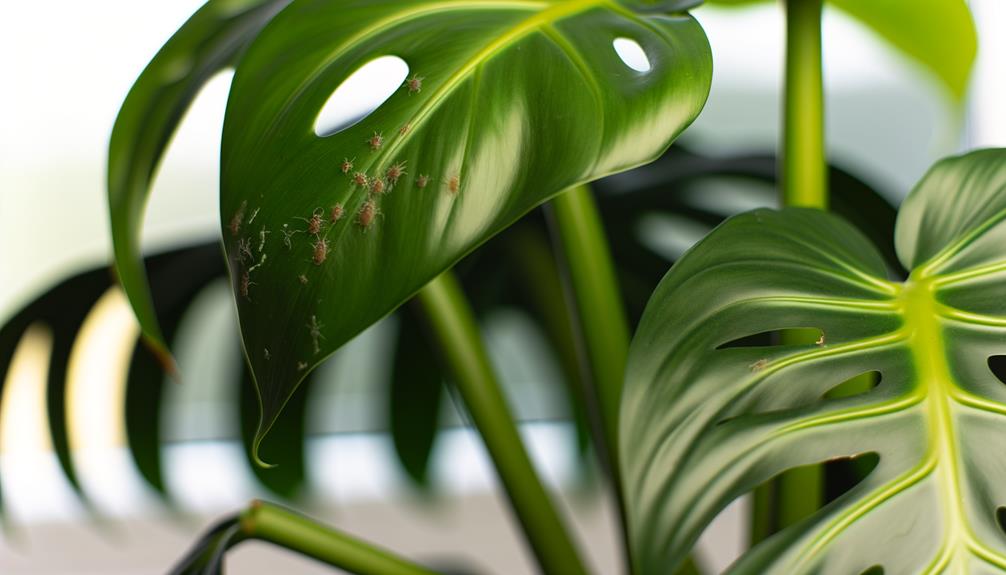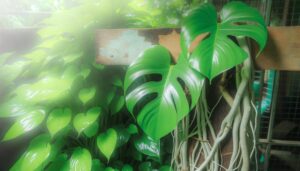Monstera Pinnatipartita Common Pests
Monstera Pinnatipartita often faces several pests. Spider mites cause leaf stippling in hot, dry conditions; control them with increased humidity and miticides.
Aphids, with pear-shaped bodies, distort growth; use insecticidal soap or neem oil. Mealybugs leave cotton-like wax secretions and sap-feed; treat with systemic insecticides or neem oil.
Scale insects attach to stems, weakening growth; manage them with horticultural oil or insecticidal soap. Thrips cause silvery leaf stippling and transmit viruses; early detection is essential.
Implementing regular inspections and integrated pest management (IPM) strategies enhances protection. For detailed pest identification and control techniques, you'll find a broader scope awaits.

Key Takeaways
- Spider mites cause stippling on Monstera Pinnatipartita leaves and thrive in hot, dry conditions.
- Aphids lead to distorted growth and can be controlled with insecticidal soap or neem oil.
- Mealybugs produce cotton-like wax secretions and sap the plant, treat with systemic insecticides.
- Scale insects attach to stems and leaves, weakening growth, managed with horticultural oil.
- Whiteflies cause chlorosis and honeydew excretion, controlled with yellow sticky traps and insecticidal soap.
Spider Mites
Spider mites, one of the most common pests affecting Monstera Pinnatipartita, are tiny arachnids that can cause significant damage by feeding on the plant's sap.
You'll notice their presence through stippling, where leaves exhibit tiny, discolored spots. This damage results from their piercing-sucking mouthparts that extract cellular contents.
Spider mites thrive in hot, dry conditions and can reproduce rapidly, exacerbating infestations. They spin fine silk webs, often visible on the undersides of leaves.
Effective control involves increasing humidity, regular inspection, and employing miticides or insecticidal soaps. It's vital to isolate affected plants to prevent the spread, as spider mites can migrate quickly.
Monitoring and early intervention are key to maintaining the health of your Monstera Pinnatipartita.
Aphids
Aphids, small sap-sucking insects, can quickly infest your Monstera Pinnatipartita, leading to distorted growth and the secretion of honeydew that attracts sooty mold. These pests typically congregate on the undersides of leaves and tender new growth. You'll notice their pear-shaped bodies and cornicles, tiny tube-like structures protruding from their abdomen.
Aphid infestations can cause chlorosis, wilting, and overall plant stress due to their phloem-feeding habits. To control aphids, consider using insecticidal soap or neem oil, ensuring thorough coverage of all plant surfaces. Introducing natural predators like ladybugs or parasitic wasps can also help manage populations biologically.
Regular monitoring and early intervention are vital to prevent severe infestations and maintain your plant's health.
Mealybugs
When you encounter mealybugs on your Monstera Pinnatipartita, you'll notice their cotton-like wax secretions on stems and leaves. Identifying these pests early is important for effective treatment, which may include systemic insecticides or neem oil applications.
Additionally, implementing preventative care such as quarantining new plants and maintaining ideal humidity can greatly reduce infestation risks.
Identifying Mealybug Infestations
Mealybugs, often identified by their cotton-like waxy secretions, manifest as small, white, soft-bodied insects clinging to the stems and undersides of Monstera Pinnatipartita leaves.
You'll notice a distinct, powdery appearance on the plant's surface, indicating their presence. These pests excrete honeydew, a sticky substance that can lead to sooty mold growth.
You'll often find them in leaf axils, nodes, and crevices where they feed on plant sap using their piercing-sucking mouthparts. Infested leaves may show chlorosis, stunted growth, or premature leaf drop.
Additionally, the plant may exhibit a general decline in vigor. Regularly inspecting your Monstera Pinnatipartita for these signs is essential for early detection and effective management of mealybug infestations.
Effective Treatment Methods
To effectively manage mealybug infestations on your Monstera Pinnatipartita, start by isolating the affected plant to prevent the pests from spreading.
Use a cotton swab dipped in isopropyl alcohol to manually remove visible mealybugs. Apply systemic insecticides containing imidacloprid for severe cases; these compounds disrupt insect nervous systems.
Neem oil, a natural insecticide, can be sprayed generously on the foliage and stems, ensuring complete coverage. Regularly inspect the undersides of leaves and nodes, as these are common hiding spots.
Repeat treatments weekly until the infestation is under control. Prune heavily infested areas and dispose of the clippings in sealed bags to avoid recontamination. Always follow safety guidelines when handling chemical treatments to protect yourself and your plant.
Preventative Care Tips
Maintaining a strict inspection routine and keeping your Monstera Pinnatipartita in peak condition greatly reduces the likelihood of mealybug infestations. Regularly examine the undersides of leaves and stem junctures for early signs of these pests. Utilize a magnifying glass to detect the cotton-like wax secreted by mealybugs.
Enhance plant vigor through ideal light exposure, proper watering, and balanced fertilization to strengthen its natural defenses. Introduce biological control agents like Cryptolaemus montrouzieri, a predatory beetle, to keep mealybug populations in check. Employ systemic insecticides containing imidacloprid as a preventative measure but make sure application aligns with integrated pest management principles.
Maintaining environmental cleanliness by removing plant debris and disinfecting pruning tools also limits pest proliferation.
Scale Insects
Scale insects, small sap-sucking pests, infest Monstera Pinnatipartita by attaching themselves to the plant's stems and leaves, often leading to weakened growth and potential secondary infections. These hemipterans possess a protective covering, making them resistant to many traditional insecticides.
You'll notice their presence through yellowing leaves, stunted growth, and a sticky substance called honeydew, which can also attract sooty mold. To manage an infestation, employ horticultural oil or insecticidal soap, ensuring thorough coverage of infested areas.
Manual removal with a cotton swab dipped in isopropyl alcohol can also be effective for small-scale invasions. Regular monitoring is essential; early detection and prompt action can prevent severe damage to your Monstera Pinnatipartita.
Thrips
Another common pest that can wreak havoc on your Monstera Pinnatipartita is thrips, tiny slender insects that feed on plant sap by puncturing the surface of leaves with their specialized mouthparts. Thrips can cause significant damage, leading to:
- Silvery or bronzed stippling on leaves due to cell collapse.
- Distorted growth as a result of feeding on young tissues.
- Black specks of excrement left behind on the foliage.
- Virus transmission, such as Tomato Spotted Wilt Virus (TSWV), which they can vector.
To identify thrips, look for these symptoms and inspect the undersides of leaves. They're often challenging to spot due to their small size and rapid movement. Early detection and intervention are essential to managing these pests effectively.
Fungus Gnats
Fungus gnats, small dark flies often mistaken for fruit flies, target Monstera Pinnatipartita by laying eggs in the moist soil, leading to root damage and impaired plant growth. These pests thrive in high humidity and organic matter, where larvae feed on fungal mycelium and plant roots. You'll notice adults flying around the plant, indicating an infestation.
Combatting fungus gnats involves reducing soil moisture and using biological controls like Bacillus thuringiensis var. israelensis. Yellow sticky traps can capture adult gnats, while beneficial nematodes target larvae in the soil. Guarantee proper drainage and avoid overwatering to prevent gnat proliferation.
Consistently monitor and adjust cultural practices to maintain an inhospitable environment for these pests, safeguarding your Monstera Pinnatipartita.
Whiteflies
You'll notice whiteflies as tiny, white-winged insects clustering on the undersides of leaves, causing chlorosis and reduced photosynthesis. Their excretions promote sooty mold growth, which further hampers the plant's health.
Implementing integrated pest management (IPM) strategies, including biological controls like Encarsia formosa, can effectively mitigate these infestations.
Identification and Symptoms
Whiteflies, small sap-sucking insects, often manifest on Monstera pinnatipartita as tiny, powdery white specks clustered on the undersides of leaves.
You'll notice several symptoms indicating their presence:
- Chlorosis: Yellowing of leaves due to the depletion of chlorophyll.
- Honeydew Excretion: Sticky substance on leaves, leading to sooty mold growth.
- Stunted Growth: Reduced vigor and development of the plant due to nutrient loss.
- Leaf Curling: Distorted leaf shape resulting from the feeding activity.
These pests are known for their rapid reproduction rate and can quickly escalate into a severe infestation.
You should regularly inspect the plant for these signs to ensure early detection and prevent substantial damage.
Their near-microscopic size demands a vigilant and methodical approach to identification.
Effective Control Methods
To effectively control whiteflies on Monstera pinnatipartita, employ integrated pest management (IPM) strategies combining mechanical, biological, and chemical methods.
Start by using yellow sticky traps to capture adult whiteflies. For biological control, introduce natural predators such as Encarsia formosa or Eretmocerus eremicus, which parasitize whitefly larvae. Regularly inspect and remove heavily infested leaves to reduce the population.
If infestations persist, apply insecticidal soap or neem oil, which disrupts whitefly feeding and reproduction. Ensure thorough coverage of the foliage to maximize efficacy. Rotate chemical treatments with different modes of action to prevent resistance.
Integrating these methods will help you maintain a healthy Monstera pinnatipartita and reduce whitefly populations effectively.
Preventative Measures
Implementing integrated pest management (IPM) strategies can lessen the likelihood of pest infestations on your Monstera Pinnatipartita. Regular monitoring and early detection are essential. Examine the plant's leaves, stems, and roots for signs of pests like spider mites and mealybugs.
Employ cultural controls by maintaining ideal humidity and avoiding overwatering, which can attract pests. Introduce beneficial insects like ladybugs to naturally reduce pest populations.
Key preventative measures include:
- Regular inspections: Check for early signs of infestation.
- Maintain hygiene: Remove dead leaves and debris around the plant.
- Optimize environment: Ensure proper light, temperature, and humidity levels.
- Biological controls: Utilize natural predators to control pest populations.
Conclusion
By keeping an eye on your Monstera pinnatipartita, you can avoid those pesky little hiccups from spider mites, aphids, mealybugs, scale insects, thrips, fungus gnats, and whiteflies.
Regular inspections, proper watering, and using natural predators or insecticidal soap can keep things under control.
Remember, a happy plant is a healthy plant, and with a bit of diligence, you'll maintain a vibrant, thriving Monstera without too many uninvited guests.
Keep up the good work, and your plant will thank you!






